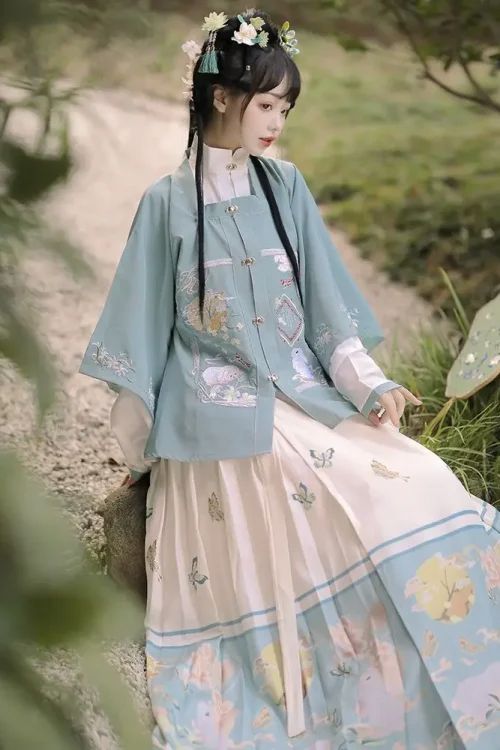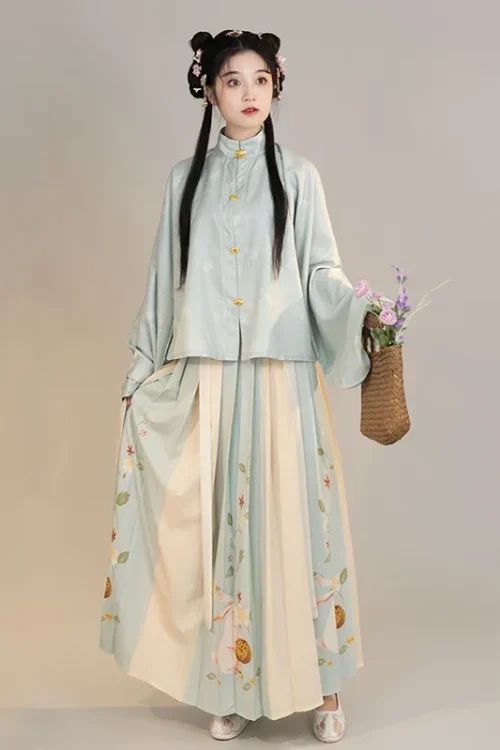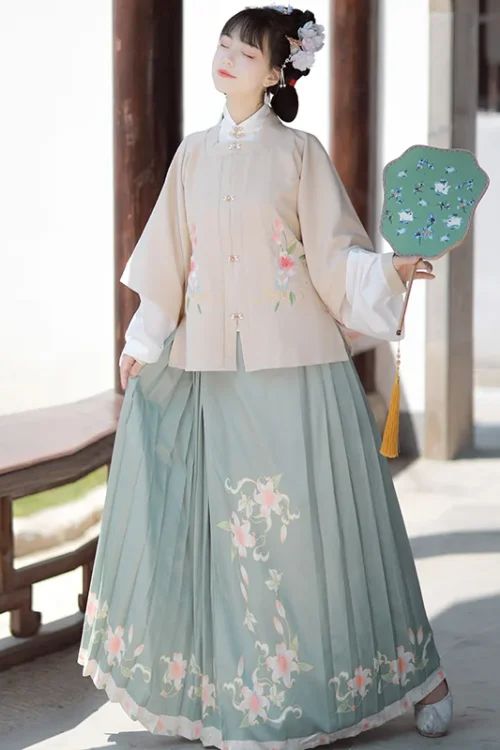Ming Dynasty’s Influence on 汉服‘s Silhouette and Design
A Pivotal Era in Hanfu Evolution
The Ming Dynasty (1368-1644) marked a pivotal era in the evolution of Hanfu, the traditional clothing of the Han Chinese. During this period, Hanfu underwent significant transformations in silhouette and design, leaving an enduring legacy that shaped future generations of fashion.

Changes in Silhouette
One of the most notable changes introduced during the Ming Dynasty was the adoption of a looser, more flowing silhouette. In contrast to the form-fitting garments of previous eras, Ming Hanfu featured wider sleeves, looser skirts, and a more relaxed overall fit. This shift towards comfort and ease of movement reflected the changing social and cultural values of the time.
Introduction of the Horse-Hoof Sleeve
Another significant innovation was the introduction of the “horse-hoof sleeve.” This unique sleeve design, characterized by its wide, flared shape, became a defining feature of Ming Hanfu. The horse-hoof sleeve added a touch of elegance and drama to the garment, while also providing greater freedom of movement for the wearer.
New Design Elements and Motifs
In addition to the silhouette, the Ming Dynasty also introduced new design elements and decorative motifs. Embroidery, which had been used sparingly in earlier periods, became a prominent feature of Ming Hanfu. Intricate floral and geometric patterns were meticulously stitched onto garments, adding a touch of luxury and sophistication.
Use of Contrasting Colors and Fabrics
The use of contrasting colors and fabrics also became more prevalent during the Ming Dynasty. Garments were often made from a combination of different materials, such as silk, cotton, and linen. This mix of textures and colors created a visually striking effect that set Ming Hanfu apart from its predecessors.
Influence Beyond Borders
The Ming Dynasty’s influence on Hanfu extended beyond its own borders. The loose, flowing silhouette and distinctive design elements of Ming Hanfu were adopted by neighboring cultures, including the Manchus and Koreans. These influences can still be seen in traditional clothing worn in these regions today.
结论
In conclusion, the Ming Dynasty played a pivotal role in shaping the evolution of Hanfu. The looser silhouette, horse-hoof sleeve, and innovative design elements introduced during this period left an enduring legacy that influenced future generations of fashion. The Ming Dynasty’s contributions to Hanfu continue to be celebrated and admired, showcasing the rich cultural heritage of the Han Chinese people.
The Rise of Embroidered Motifs and Decorative Elements in Ming Hanfu
A Turning Point in Hanfu Evolution
The Ming Dynasty (1368-1644) marked a significant turning point in the evolution of Hanfu, the traditional clothing of the Han Chinese. During this period, Hanfu underwent a series of transformations that would profoundly influence its future development.

Emergence of Elaborate Embroidery
One of the most notable changes was the rise of embroidered motifs and decorative elements. Embroidered designs had been used in Hanfu for centuries, but it was during the Ming Dynasty that they became truly elaborate and widespread. Artisans employed a variety of techniques, including silk embroidery, gold thread embroidery, and beadwork, to create intricate and eye-catching patterns.
Popularity of Floral and Animal Motifs
Floral motifs were particularly popular, with peonies, lotus flowers, and chrysanthemums being common choices. These motifs often carried symbolic meanings, representing prosperity, purity, and longevity. Animals, such as dragons, phoenixes, and cranes, were also frequently depicted, as they were believed to possess auspicious qualities.
Incorporation of Decorative Elements
In addition to embroidery, other decorative elements were also incorporated into Ming Hanfu. These included ribbons, tassels, and jade ornaments. Ribbons were often used to trim the edges of garments or to create decorative bows. Tassels were added to hats and belts, while jade ornaments were worn as pendants or hair accessories.
Vibrant Color Palette
The use of bright colors was another characteristic of Ming Hanfu. While earlier dynasties had favored more subdued hues, Ming fashion embraced vibrant shades of red, yellow, green, and blue. These colors were often combined in bold and contrasting patterns, creating a visually striking effect.
New Garment Styles
The Ming Dynasty also saw the introduction of new garment styles. The most iconic of these was the “horse-hoof sleeve,” a wide, flowing sleeve that resembled the hoof of a horse. This sleeve style was particularly popular among women and became a defining feature of Ming Hanfu.
Introduction of the Cloud Collar
Another innovation was the “cloud collar,” a wide, rectangular collar that was worn over the shoulders. Cloud collars were often decorated with intricate embroidery or beadwork and added a touch of elegance to any outfit.
结论
The changes that occurred in Hanfu during the Ming Dynasty had a lasting impact on its future development. The rise of embroidered motifs and decorative elements, the use of bright colors, and the introduction of new garment styles all contributed to the creation of a unique and visually stunning aesthetic that would continue to inspire generations of Hanfu enthusiasts.
Ming Hanfu’s Legacy: Its Impact on Later Fashion Trends
A Significant Turning Point
The Ming Dynasty (1368-1644) marked a significant turning point in the evolution of Hanfu, the traditional clothing of the Han Chinese. Ming Hanfu styles, characterized by their elegance, comfort, and practicality, left an enduring legacy that shaped future generations of fashion.

Introduction of the Horse-Hoof Sleeve
One of the most notable innovations of Ming Hanfu was the introduction of the “horse-hoof sleeve.” This wide, flowing sleeve, resembling the shape of a horse’s hoof, provided ample room for movement and ventilation. It became a defining feature of Ming Hanfu and was later adopted by other cultures, including the Japanese kimono.
Shift Towards Tailored Silhouettes
Another significant change was the shift towards a more tailored silhouette. Ming Hanfu garments were often fitted to the body, emphasizing the wearer’s figure. This departure from the loose, flowing robes of previous dynasties created a more refined and sophisticated look.
Vibrant Colors and Intricate Embroidery
The use of vibrant colors and intricate embroidery also became prominent during the Ming period. Hanfu garments were adorned with auspicious symbols, such as dragons, phoenixes, and flowers, which represented power, prosperity, and good fortune. These decorative elements added a touch of opulence and grandeur to Ming Hanfu.
New Types of Garments
Furthermore, Ming Hanfu introduced new types of garments, such as the “beizi” (a short jacket) and the “shan” (a long skirt). These garments provided greater versatility and allowed for a wider range of outfits.
Legacy Beyond the Ming Dynasty
The legacy of Ming Hanfu extended beyond its own time. Qing Dynasty (1644-1912) fashion, while influenced by Manchu culture, still incorporated elements of Ming Hanfu, such as the horse-hoof sleeve and tailored silhouettes.
Revival in the 20th Century
In the 20th century, there was a revival of interest in traditional Chinese culture, including Hanfu. Contemporary Hanfu enthusiasts have drawn inspiration from Ming Hanfu styles, creating modern interpretations that blend historical authenticity with contemporary aesthetics.
结论
Today, Ming Hanfu continues to be celebrated as a symbol of Chinese cultural heritage. Its elegant designs, practical features, and enduring influence have made it a timeless fashion icon that continues to inspire generations.
